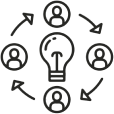How might we Add/remove
Purpose:
The purpose of the method is to reformat the overall problem into suggested solutions by asking “How might we”.
The method will open up the solution space and help you to highlight which aspects of the problem are important to take into account for your development process.
Tips to include participants who are not able to:

See

Move

Hold

Think

Speak

Hear

Focus

Belong
Overview
Input
A problem
Output
Ideas for how to encounter the overall problem.
Complexity
Moderate
Time
15 min+
Participants
2-10+
Activity
- Can write
- Can reflect upon the problem
- Can communicate the questions formed
Step by step:
Hand out post-its and pens to all participants (1 min).
Explain the method by showing the template and go through a problem that does not resemble the overall problem of the workshop (2 min).
Ask the participants to familiarize themselves with the overall problem and brainstorm individually on sentences starting with “How might we….” that can solve the problem – write it on a post-it (3 min).
Ask the participants to hang the post-its on the template (1 min).
Ask the participants to complete a second round of individual brainstorming (3 min).
Participants should hang the post-its on the template again (1 min).
Step 6 & 7 are repeated until you can tell the participants are out of ideas for HMW sentences. Each brainstorm round should be 3 minutes.
Present the HMW sentences(1-2 min per. participant).
When doing this method you should consider:
It is important that the facilitator observes how the ‘How might we’ questions are stated as they can easily be too general. An example of a poor HMW question could be:
How might we tell users which form to complete to file their taxes?
This question does not emphasize the root cause why it is poor. It is much stronger saying:
How might we make users feel confident they are filing their taxes correctly?
Materials needed:
- Pens
- Post-its
- Space
- Template




